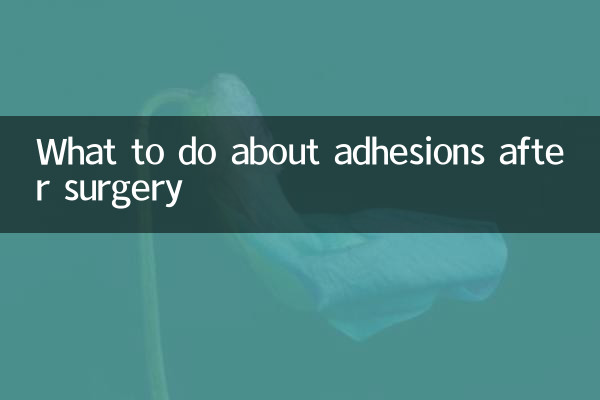What to do about adhesions after surgery
Postoperative adhesions are a common problem that many patients may face after surgery, especially after abdominal, pelvic, or orthopedic surgery. Adhesions can lead to problems such as chronic pain, intestinal blockage, and even infertility. This article will combine the hot topics and hot content on the Internet in the past 10 days to provide you with a detailed analysis of the causes, preventive measures and treatment methods of postoperative adhesions.
1. Causes of postoperative adhesions

Postoperative adhesion is mainly due to the inflammatory response triggered by surgical trauma, leading to abnormal healing between tissues. The following are common causes:
| Cause | Specific performance |
|---|---|
| surgical trauma | Cuts or tissue damage trigger an inflammatory response |
| ischemia | Insufficient blood supply to tissues leading to abnormal healing |
| foreign matter residue | Surgical suture material or hemostatic material triggering reaction |
| infection | Postoperative infection increases inflammation and risk of adhesions |
2. Preventive measures for postoperative adhesions
Prevention is the key to reducing adhesions after surgery. The following are the prevention methods that have been hotly discussed in the past 10 days:
| Precautions | Specific methods |
|---|---|
| minimally invasive surgery | Prioritize minimally invasive techniques such as laparoscopy to reduce tissue damage |
| Anti-adhesion material | Use absorbable anti-adhesion films or gels |
| Early postoperative activities | Promote blood circulation and reduce adhesion formation |
| pharmacological intervention | Using nonsteroidal anti-inflammatory drugs or anticoagulant drugs |
3. Treatment methods for post-surgical adhesions
If adhesions have occurred, treatment methods need to be selected based on the severity. The following are treatment options that have been hotly discussed recently:
| Treatment | Scope of application |
|---|---|
| physical therapy | Relieve mild adhesions with massage and hot compress |
| drug treatment | Use anti-inflammatory drugs or enzymes to help dissolve adhesions |
| surgical treatment | Severe adhesions require another surgery to release them |
| Traditional Chinese Medicine Conditioning | Acupuncture and Chinese medicine assist in improving blood circulation |
4. Recent hot questions and answers: Frequently asked questions about adhesions after surgery
According to the search data of the entire Internet in the past 10 days, the following questions have received the most attention:
1. Will adhesions disappear on their own after surgery?
Mild adhesions may soften over time, but moderate to severe adhesions usually require intervention.
2. How to determine whether you have postoperative adhesions?
Common symptoms include localized pain, limited mobility, and digestive problems (such as after abdominal surgery). Diagnosis needs to be confirmed by imaging examination.
3. Are anti-adhesion products really effective?
Clinical studies have shown that some anti-adhesion films can reduce the risk of adhesions by more than 50%, but the effectiveness varies by product and individual constitution.
5. Expert advice
Based on recent expert interviews, it is recommended that:
1. Choosing an experienced surgeon and standardizing the operation can significantly reduce the risk of adhesion.
2. Follow the doctor’s advice to move around as soon as possible after surgery, but avoid strenuous exercise.
3. If abnormal symptoms occur, you should be reviewed in time without delay.
Conclusion
Although post-surgical adhesions are common, they can be effectively managed through scientific prevention and treatment. If you are facing postoperative recovery problems, it is recommended to consult a professional doctor in time to develop a personalized plan. Remember, early intervention is key to avoiding serious complications.

check the details

check the details